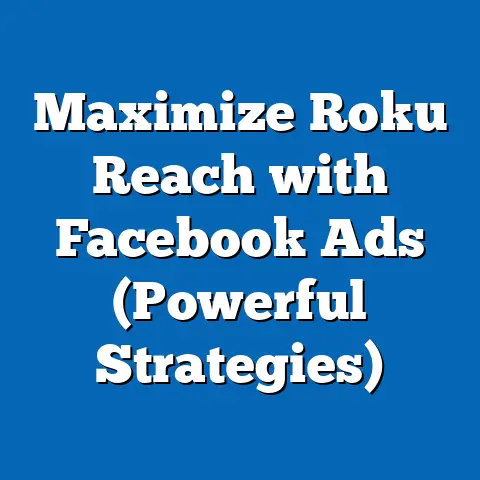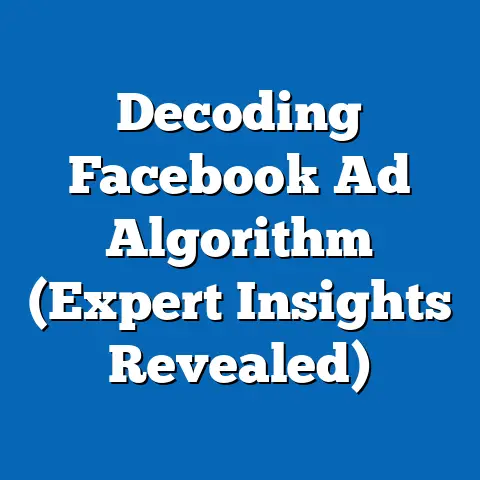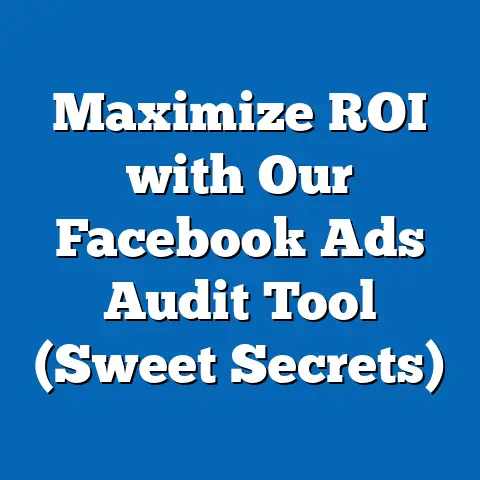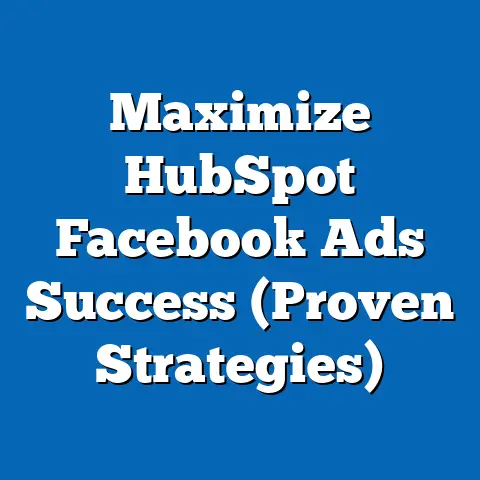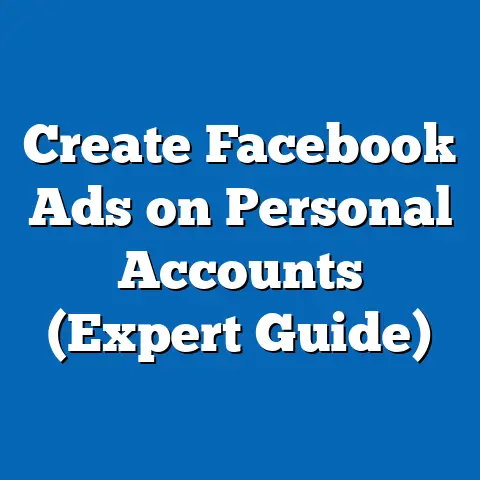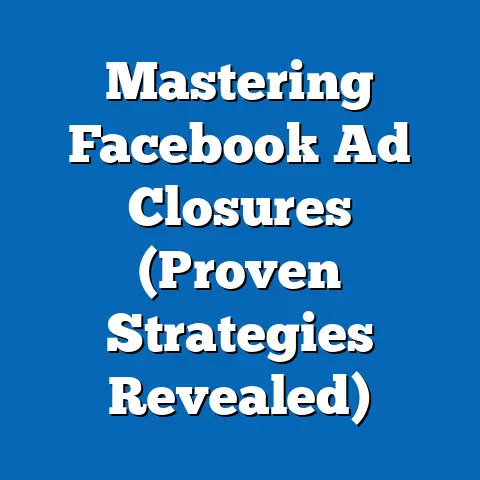Optimize Facebook Ads: Average CPC Insights (Expert Guide)
But don’t worry, I’m here to help you navigate the wild world of Facebook CPC and, hopefully, save you from similar financial mishaps. Think of this as your ultimate guide to understanding, optimizing, and ultimately conquering the CPC beast.
Section 1: Understanding CPC in Facebook Ads
So, what exactly is CPC? Let’s break it down.
What is CPC?
CPC, or Cost Per Click, is the amount you pay each time someone clicks on your Facebook ad. Simple, right? It’s one of the most common bidding strategies in online advertising and a key metric for measuring the effectiveness of your campaigns.
Why is CPC Important?
Think of your ad budget as a limited supply of delicious cookies. Each click costs you a certain amount. If your CPC is too high, you’ll run out of cookies (budget) before you even get a chance to satisfy anyone’s hunger (reach your goals). A lower CPC means you can get more clicks for the same amount of money, increasing your reach and potential conversions.
How is CPC Calculated?
The actual CPC you pay is determined through an auction system. Facebook’s algorithm considers several factors, including your bid, ad quality, and the relevance of your ad to the target audience. You’re essentially bidding against other advertisers to show your ad to the same people.
The formula looks something like this:
Your CPC = (Cost of the ad / Number of clicks)
CPC in Real Life: The Exclusive Club Analogy
Imagine you’re trying to get into a super exclusive club. The bouncer (Facebook’s algorithm) decides who gets in based on a few things:
- How much you’re willing to pay (Your Bid): Are you flashing a $100 bill or trying to sneak in with a crumpled five?
- How good you look (Ad Quality): Are you dressed to impress or did you just roll out of bed?
- How well you fit in (Ad Relevance): Are you the type of person who’d actually enjoy the club, or are you just there to cause trouble?
The higher your bid, the better your outfit, and the more you seem like you belong, the better your chances of getting in (and the lower your “entry fee,” or CPC, might be).
Key Takeaway: CPC is the price you pay for each click on your Facebook ad. Understanding it is crucial for maximizing your budget and achieving your advertising goals. A lower CPC means more clicks, more reach, and more potential conversions. Think of it as getting more bang for your buck…or more cookies for your budget!
Section 2: Average CPC Trends in Facebook Ads
Okay, now that we know what CPC is, let’s dive into the numbers. What’s considered “good” or “bad” when it comes to CPC? The answer, as always, is: it depends. But understanding the trends can give you a good starting point.
Recent CPC Trends (The Rollercoaster Ride)
In recent years, the average CPC on Facebook has fluctuated quite a bit. Several factors contribute to these changes, including:
- Increased Competition: More businesses are advertising on Facebook than ever before, driving up the competition for ad space.
- Algorithm Updates: Facebook constantly tweaks its algorithm, which can impact ad delivery and CPC.
- Economic Factors: Economic downturns and shifts in consumer spending can influence advertising budgets and, consequently, CPC.
- Seasonality: CPC tends to increase during peak advertising seasons like the holidays or Black Friday.
Generally, I’ve observed that CPC has been trending upwards, especially in highly competitive industries. This means it’s more important than ever to optimize your campaigns and make every click count.
CPC by Industry (The Price of Entry)
The average CPC can vary significantly depending on your industry. Here’s a general overview (remember, these are averages and can change):
- Retail: Typically sees higher CPCs, especially during peak shopping seasons.
- Technology: Also competitive, with relatively high CPCs due to the high demand for tech products and services.
- Healthcare: Can have lower CPCs compared to other industries, but it depends on the specific niche.
- Finance: Often higher CPCs due to the high value of potential leads and customers.
- Education: Generally lower CPCs, but it depends on the type of educational program.
For example, I once worked with a small e-commerce business selling handmade jewelry. Their CPC was significantly higher than a local dentist’s because the jewelry market is incredibly saturated on Facebook. We had to get really creative with our targeting and ad creatives to bring those costs down.
Humorous Analogy: The Stock Market of Clicks
Think of the fluctuating CPC rates like the stock market. One day, your favorite stock (ad) is soaring high, and the next day it’s plummeting. Just like the market, the CPC can be a rollercoaster ride, so hold onto your wallets! You need to be prepared to adapt and adjust your strategy as the market (Facebook’s ad landscape) changes.
Statistical Data (Numbers Don’t Lie… Mostly)
While specific numbers change frequently, here’s a general range for average CPC on Facebook:
- Overall Average CPC: $0.50 – $2.00
- Average CPC for Link Clicks: $0.20 – $1.00
Keep in mind that these are just averages. Your actual CPC will depend on your industry, targeting, ad quality, and other factors.
Key Takeaway: Average CPCs on Facebook are influenced by competition, algorithm changes, economic factors, and seasonality. Industry benchmarks provide a helpful starting point, but your actual CPC will depend on your specific circumstances. Stay informed about these trends and be prepared to adjust your strategy accordingly.
Section 3: Factors Influencing CPC in Facebook Ads
Now that we’ve looked at the trends, let’s get into the nitty-gritty of what actually causes those CPC fluctuations. Understanding these factors is the key to controlling your costs.
1. Audience Targeting (The Right Bait)
Your target audience is one of the biggest factors influencing your CPC. The more specific and well-defined your audience, the lower your CPC is likely to be.
- Broad Targeting: Targeting a very broad audience (e.g., everyone in the United States) will result in higher CPCs because you’re competing with a massive number of advertisers.
- Narrow Targeting: Targeting a niche audience with specific interests and demographics will typically result in lower CPCs because you’re competing with fewer advertisers.
- Custom Audiences: Using custom audiences (e.g., website visitors, email subscribers) can also lower your CPC because these people are already familiar with your brand.
Humorous Analogy: The Fishing Trip
Think of audience targeting like a fishing trip. The better your bait (your ad), the bigger the catch (more clicks). But if you’re casting your line into a kiddie pool (broad audience), well… good luck! You need to find the right fishing spot (niche audience) to reel in the big ones (qualified leads) without wasting all your bait (budget).
2. Ad Placement (Location, Location, Location)
Where your ad is shown on Facebook also impacts your CPC. Different placements have different costs and performance.
- Facebook Feed: The most common placement, but also one of the most competitive, leading to higher CPCs.
- Instagram Feed: Can be slightly less expensive than the Facebook Feed, especially if your target audience is more active on Instagram.
- Audience Network: A network of third-party apps and websites where your ads can be shown. Typically has lower CPCs but can also have lower engagement rates.
- Messenger: Ads in Messenger can be effective, but the CPC can vary depending on the ad format and targeting.
3. Ad Quality and Relevance (The First Impression)
Facebook rewards high-quality, relevant ads with lower CPCs. The algorithm considers several factors when determining ad quality, including:
- Relevance Score: A score from 1 to 10 that indicates how relevant your ad is to your target audience.
- Engagement Rate: The percentage of people who engage with your ad (e.g., likes, comments, shares).
- Landing Page Experience: How well your landing page matches your ad and provides a positive user experience.
4. Bidding Strategy (The Art of Negotiation)
Your bidding strategy also plays a crucial role in determining your CPC. Facebook offers several bidding options:
- Lowest Cost: Facebook automatically bids to get you the most clicks for your budget. Can result in lower CPCs, but may not always deliver the best results.
- Cost Cap: You set a target CPC, and Facebook tries to stay within that limit. Provides more control over your costs, but may limit your reach.
- Bid Cap: You set a maximum bid for each click. Similar to Cost Cap, but gives you even more control over your spending.
- Value Optimization: Facebook tries to find people who are most likely to convert based on your campaign objective. Can result in higher CPCs, but also higher ROI.
5. Competition (The Crowd)
The level of competition in your target audience also influences your CPC. If many advertisers are targeting the same people, the cost of reaching them will be higher.
Key Takeaway: CPC is influenced by a complex interplay of factors, including audience targeting, ad placement, ad quality, bidding strategy, and competition. By understanding these factors, you can optimize your campaigns and reduce your costs.
Here are some actionable strategies you can implement today:1. A/B Testing (The Scientific Approach)
A/B testing is the process of experimenting with different versions of your ads to see which performs best. This is essential for optimizing your CPC.
- Test Different Ad Creatives: Try different images, videos, and ad copy to see which resonates most with your audience.
- Test Different Headlines and Call-to-Actions: Experiment with different headlines and CTAs to see which generates the most clicks.
- Test Different Targeting Options: Try different audiences, interests, and demographics to see which delivers the lowest CPC.
Humorous Analogy: The Recipe Experiment
Think of A/B testing like experimenting with a new recipe. You wouldn’t just throw everything in the pot and hope for the best, would you? You’d try different ingredients, different cooking times, and different spices until you found the perfect combination. A/B testing is the same thing: you’re experimenting with different elements of your ads until you find the “recipe” that delivers the lowest CPC and the best results.
2. Utilize the Facebook Pixel (The Spyglass)
The Facebook Pixel is a small piece of code that you install on your website. It allows you to track user behavior and optimize your ads for conversions.
- Track Conversions: The Pixel allows you to track which ads are driving the most conversions, so you can focus on those.
- Create Custom Audiences: You can use the Pixel to create custom audiences of website visitors, which can be highly effective for retargeting.
- Optimize for Value: The Pixel allows you to optimize your ads for value, which means Facebook will try to find people who are most likely to make a purchase or take another desired action.
3. Refine Audience Targeting (The Sniper Approach)
As mentioned earlier, your target audience is a critical factor in determining your CPC.
- Use Layered Targeting: Combine multiple interests and demographics to create a highly specific audience.
- Exclude Irrelevant Audiences: Exclude audiences that are unlikely to be interested in your product or service.
- Use Lookalike Audiences: Create lookalike audiences based on your existing customers or website visitors.
4. Improve Ad Creatives (The Visual Appeal)
Your ad creatives are the first thing people see, so they need to be eye-catching and engaging.
- Use High-Quality Images and Videos: Avoid blurry or pixelated images. Use professional-quality visuals that grab attention.
- Write Compelling Ad Copy: Your ad copy should be clear, concise, and persuasive. Highlight the benefits of your product or service and include a strong call-to-action.
- Use Storytelling: Tell a story that resonates with your audience and makes them want to learn more.
5. Optimize Landing Page Experience (The Welcome Mat)
Your landing page is where people go after they click on your ad. It needs to be relevant to your ad and provide a positive user experience.
- Match Your Landing Page to Your Ad: Make sure your landing page is consistent with your ad in terms of messaging and visuals.
- Make it Easy to Convert: Ensure your landing page has a clear call-to-action and makes it easy for people to take the desired action (e.g., make a purchase, sign up for a newsletter).
- Optimize for Mobile: Make sure your landing page is mobile-friendly, as a large percentage of Facebook users access the platform on their mobile devices.
Key Takeaway: Optimizing your Facebook ads for lower CPC requires a multi-faceted approach. A/B testing, utilizing the Facebook Pixel, refining audience targeting, improving ad creatives, and optimizing your landing page experience are all essential strategies for reducing your costs and maximizing your ROI.
Section 5: Real-Life Case Studies
Let’s take a look at some real-life examples of brands that successfully optimized their Facebook ads and saw a reduction in CPC.
Case Study 1: The E-commerce Startup
- Challenge: A new e-commerce startup selling organic skincare products was struggling with high CPCs on Facebook. They were targeting a broad audience and using generic ad creatives.
- Strategy: They implemented A/B testing to experiment with different ad creatives and targeting options. They also refined their audience targeting to focus on people interested in organic skincare and natural living.
- Results: After implementing these strategies, they saw a 40% reduction in their CPC and a 20% increase in their conversion rate.
Case Study 2: The Local Restaurant
- Challenge: An online course provider was struggling to generate leads on Facebook. They were using a generic lead magnet and targeting a broad audience.
- Strategy: They created a more compelling lead magnet that was highly relevant to their target audience. They also refined their audience targeting to focus on people interested in specific topics related to their courses.
- Results: After implementing these strategies, they saw a 50% reduction in their CPC and a significant increase in the number of leads generated.
Humorous Analogy: The Marketing Makeover
These case studies are like giving your Facebook ads a marketing makeover. You’re taking something that’s not working and transforming it into a lean, mean, lead-generating machine. If these brands can succeed, you too can turn your ad budget into a lean, mean marketing machine instead of a money pit!
Key Takeaway: These case studies demonstrate that optimizing your Facebook ads for lower CPC is possible with the right strategies. By implementing A/B testing, refining audience targeting, improving ad creatives, and optimizing your landing page experience, you can significantly reduce your costs and improve your results.
Section 6: Common Mistakes That Lead to Higher CPC
Now, let’s talk about the things you should avoid doing. These are the common pitfalls that can lead to inflated CPCs and wasted ad spend.
1. Ignoring Your Relevance Score (The Popularity Contest)
Your Relevance Score is a key indicator of how well your ad is resonating with your target audience. If your Relevance Score is low, your CPC will be higher.
- Mistake: Ignoring your Relevance Score and continuing to run ads that are not relevant to your audience.
- Solution: Monitor your Relevance Score and make adjustments to your targeting, ad creatives, or landing page to improve it.
2. Using Low-Quality Images or Videos (The Unflattering Photo)
Your ad creatives are the first thing people see, so they need to be high-quality and visually appealing.
- Mistake: Using blurry, pixelated, or unprofessional-looking images or videos.
- Solution: Invest in professional-quality visuals or learn how to create compelling visuals yourself.
3. Writing Generic Ad Copy (The Bland Message)
Your ad copy should be clear, concise, and persuasive. It should highlight the benefits of your product or service and include a strong call-to-action.
- Mistake: Writing generic ad copy that doesn’t resonate with your audience.
- Solution: Craft compelling ad copy that speaks to the needs and interests of your target audience.
4. Targeting Too Broadly (The Scattershot Approach)
Targeting a very broad audience will result in higher CPCs because you’re competing with a massive number of advertisers.
- Mistake: Targeting a very broad audience without any specific interests or demographics.
- Solution: Refine your audience targeting to focus on a niche audience with specific interests and demographics.
5. Not Monitoring Your Campaigns (The Set-It-and-Forget-It Mentality)
Facebook advertising is not a “set-it-and-forget-it” activity. You need to constantly monitor your campaigns and make adjustments as needed.
- Mistake: Setting up a campaign and then not monitoring it or making any adjustments.
- Solution: Regularly monitor your campaigns and make adjustments to your targeting, ad creatives, or bidding strategy based on the data.
Humorous Analogy: The Dating Faux Pas
These mistakes are like common dating faux pas. Showing up to a formal dinner in flip-flops (low-quality images), telling the same boring story over and over again (generic ad copy), or not paying attention to your date’s cues (ignoring your Relevance Score) are all sure ways to turn someone off. Similarly, these mistakes will turn off your audience and drive up your CPC.
Key Takeaway: Avoiding these common mistakes is crucial for optimizing your Facebook ads and reducing your CPC. Pay attention to your Relevance Score, use high-quality visuals, write compelling ad copy, refine your audience targeting, and monitor your campaigns regularly.
Section 7: The Future of CPC in Facebook Advertising
So, what does the future hold for CPC on Facebook? Let’s take a look at some potential trends and predictions.
1. Continued Rise in CPC (The Inflation Effect)
As more businesses continue to advertise on Facebook, competition for ad space will likely increase, driving up CPC.
2. Increased Importance of Ad Quality (The Value Proposition)
Facebook will likely continue to prioritize ad quality and relevance, rewarding advertisers who create high-quality, engaging ads with lower CPCs.
3. The Rise of AI and Machine Learning (The Smart Assistant)
AI and machine learning will play an increasingly important role in Facebook advertising. These technologies can help advertisers optimize their campaigns, improve their targeting, and reduce their CPC.
4. The Metaverse and Virtual Advertising (The New Frontier)
As the metaverse continues to develop, new advertising opportunities will emerge in virtual reality and augmented reality. This could potentially create new ways to reach audiences and reduce CPC.
Humorous Analogy: The Crystal Ball
Predicting the future of CPC is like looking into a crystal ball. We can make educated guesses based on current trends, but ultimately, no one knows for sure what will happen. If trends continue, we might soon be bidding in virtual reality—just make sure your avatar has a good ad strategy!
Key Takeaway: The future of CPC in Facebook advertising is uncertain, but it’s likely that competition will continue to increase, ad quality will become even more important, and AI and machine learning will play a more prominent role. Stay informed about these trends and be prepared to adapt your strategy accordingly.
We’ve defined CPC, explored the factors that influence it, discussed strategies for optimizing your ads, and looked at some real-life case studies.The key takeaways are:
- CPC is the price you pay for each click on your Facebook ad.
- Several factors influence CPC, including audience targeting, ad placement, ad quality, bidding strategy, and competition.
- You can optimize your Facebook ads for lower CPC by implementing A/B testing, utilizing the Facebook Pixel, refining audience targeting, improving ad creatives, and optimizing your landing page experience.
- Avoiding common mistakes, such as ignoring your Relevance Score, using low-quality visuals, writing generic ad copy, and targeting too broadly, is crucial for reducing your costs.
- The future of CPC in Facebook advertising is uncertain, but it’s likely that competition will continue to increase, ad quality will become even more important, and AI and machine learning will play a more prominent role.
Remember, in the world of Facebook ads, the only thing worse than a high CPC is having to explain it to your accountant! So, go forth, optimize your campaigns, and conquer the CPC beast! Good luck, and happy advertising!

